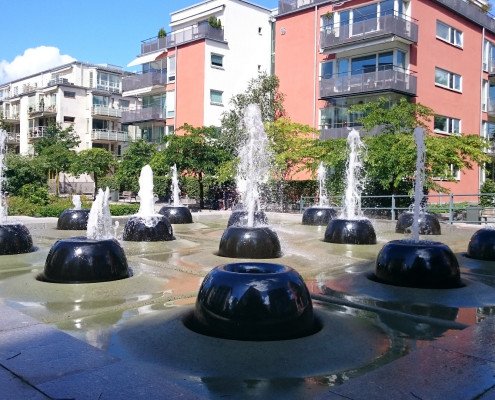Water and Sewage
One of Hammarby Sjöstad’s environmental goals is to halve water consumption. Stockholm residents use 200 litres of water/person/ day. The goal in Hammarby Sjöstad is 100 litres, and thanks to eco-friendly installations, consumption levels are currently at around 150 litres.
Cleaner wastewater is another goal: the quantities of environmentally harmful substances reaching the archipelago via the treated wastewater shall be reduced and the aim is also to recycle cleaner sewage sludge to the agricultural sector. The level of hazardous substances shall be reduced by 50 % and 95 % of the phosphorus shall be separated out and recycled for use on farms.
Cutting edge technology evaluated
Sjöstadsverket, a test treatment plant for wastewater from the equivalent of 600 people in Hammarby Sjöstad, has been built in order to evaluate new technology. The four treatment lines being tested use chemical, physical and biological processes. The wastewater sent to the local treatment plant comes exclusively from the residential units in the area and not from surface water and industries, and the levels of contaminant it contains are, therefore, hopefully minimal.
Biogas extracted from sewage sludge
The sewage sludge from the treatment plants is biodigested and biogas extracted. Biogas, the most eco-friendly fuel currently available, is used by buses and approximately 1,000 gas stoves in Hammarby Sjöstad. The sludge is then used as fertiliser.
Storm water
Storm water, rainwater and melt water are all processed locally.
Storm water from city block ground is infiltrated into the soil or channelled to Sickla Kanal, Hammarby Kanal or Danvikskanal. A storm water canal that conducts water from courtyards, via numerous small gutters, runs through the Sjöstad parterre, from where it is carried on into Hammarby Sjö through the water ladder designed by artist, Dag Birkeland.
Storm water from roads is treated in open or closed treatment plants and then carried out into Hammarby Sjö.
Green roofs
The green roofs covered in sedum plants visible on several buildings are designed to collect rainwater, delay it, and then shed it. The plants also help provide heat insulation and, at the same time, create living green areas in the townscape.

